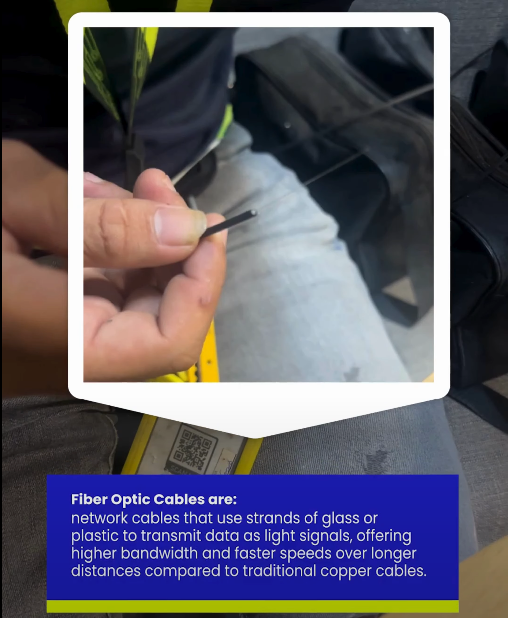Structured Cabling Installation at Secret Paradise Resort – 2nd Progress Update. Introduction. The second progress update for the Structured Cabling Installation at Secret Paradise Resort highlights important developments that took place during …
Understanding Fiber Optic Cables and How to Terminate Them.

Introduction
In today’s digital age, the demand for faster, more reliable communication and internet connectivity has increased exponentially. At the heart of this technological revolution lies fiber optic cable—a medium that is redefining the way data is transmitted across the world. This article delves into what fiber optic cables are, their characteristics, types, advantages, and offers a detailed step-by-step guide on how to terminate them correctly.
Informational Video.
What are Fiber Optic Cables?
Fiber optic cables are high-speed data transmission media that use light instead of electricity to transfer information. Unlike traditional copper cables that rely on electrical signals, fiber optics use thin strands of glass or plastic—known as optical fibers—to carry data in the form of light pulses.
Each fiber strand is approximately the thickness of a human hair and can carry huge amounts of data over long distances with minimal loss. This capability makes fiber optic cables ideal for internet backbone infrastructure, high-speed data centers, telecommunications, and enterprise networks.
How Do Fiber Optic Cables Work?
At its core, fiber optics operate using the principle of total internal reflection. A light signal, often generated by a laser or LED, is transmitted down the fiber core, where it bounces off the internal walls (cladding) in a zigzag pattern until it reaches its destination. Because light travels faster than electricity and suffers less attenuation (signal loss), fiber optics are significantly more efficient and reliable than their copper counterparts.
Main Components of a Fiber Optic Cable.
Core – The central part of the fiber through which light travels. Made from glass or plastic.
Cladding – A layer surrounding the core that reflects light back into the core.
Buffer Coating – Protective coating that shields the fiber from physical damage and moisture.
Strengthening Members – Typically made of aramid yarn (like Kevlar) to protect against tension during installation.
Outer Jacket – The external layer that protects the cable from environmental factors.
Types of Fiber Optic Cables.
There are two main categories of fiber optic cables:
1. Single-mode Fiber (SMF)
Core size: Approximately 8 to 10 microns
Transmission: Carries light directly down the fiber
Distance: Ideal for long-distance communication (up to 100+ km)
Application: Used in telecommunication companies, long-haul networks, and ISPs
2. Multimode Fiber (MMF)
Core size: 50 or 62.5 microns
Transmission: Allows multiple modes (light paths) to travel simultaneously
Distance: Best for short-range communication (up to 2 km)
Application: LANs, data centers, building-to-building connectivity
Advantages of Fiber Optic Cables.
High Bandwidth – Fiber optics can handle vast amounts of data at extremely high speeds.
Low Signal Loss – Minimal attenuation allows signals to travel longer without degradation.
Immunity to Electromagnetic Interference (EMI) – Not affected by nearby electrical equipment.
Security – Difficult to tap into without detection, making it ideal for secure communication.
Durability – Resistant to harsh environmental conditions.
Lightweight and Flexible – Easier to install in tight spaces than copper cabling.
Common Applications of Fiber Optic Cables.
Internet and broadband infrastructure.
Backbone for enterprise and campus networks.
Medical imaging and surgical equipment.
Industrial automation systems.
Television and broadcasting services.
Military and aerospace communication.
Fiber Optic Cable Termination: Why is it Important?
Termination refers to the process of installing a connector on the end of a fiber optic cable so that it can interface with other equipment (like switches, routers, or patch panels). Proper termination is crucial because it affects:
Signal transmission quality
Ease of installation and maintenance
Mechanical stability
Connection reliability
🔧 Tools and Materials Used for Termination.
For this fiber optic termination process, we used the following tools and materials:
Fiber Optic Cables
Wire Strippers (for removing the outer jacket and buffer coating)
SC/UPC Fiber Optic Connectors
Fiber Cleaver (for precise cutting of the fiber core)
Visual Fault Locator (VFL) (to test continuity and connector quality)
These essential tools allowed for a streamlined and efficient termination process using a field-installable, pre-polished connector method—ideal for quick, clean, and low-loss terminations without requiring epoxy or polishing.
🧰 Step-by-Step Guide to Terminating Fiber Optic Cables (Field-Installable SC/UPC).
Here is a simplified walkthrough of how we terminated the fiber using pre-polished SC/UPC connectors with the tools listed above:
Step 1: Prepare the Cable.
Cut the fiber optic cable to your required length.
Use the wire stripper to remove the outer jacket carefully, exposing the internal buffer tube.
Strip off the buffer coating (usually 250μm or 900μm) to expose the bare optical fiber.
Handle the fiber gently and avoid excessive bending to prevent breakage.
Tip: Always wear safety glasses when handling bare fiber to protect against glass splinters.
Step 2: Clean the Fiber.
Use a lint-free wipe moistened with isopropyl alcohol to clean the bare glass fiber thoroughly. This step ensures no dust or debris interferes with signal transmission or the connector seating.
Step 3: Cleave the Fiber.
Place the cleaned fiber into the fiber cleaver, aligning it properly according to the tool’s markings.
Make a clean cleave to ensure a smooth, flat fiber tip—this is critical for minimizing insertion loss when connecting.
Step 4: Insert the Fiber into the SC/UPC Connector.
Open the latch of the pre-polished SC/UPC connector.
Gently insert the cleaved fiber until it touches the pre-polished internal stub of the connector.
You may feel slight resistance or see the fiber alignment visually through the connector’s body (depending on the type).
Lock or clamp the connector body to secure the fiber in place.
Step 5: Verify with Visual Fault Locator (VFL).
Connect the terminated SC/UPC connector to a Visual Fault Locator.
Activate the VFL to send a red laser through the fiber.
If the termination is done correctly, light should pass through the connector with minimal visible leakage.
If there’s significant light escaping from the connector body, the fiber may be misaligned or improperly seated—re-terminate if necessary.
🔁 Alternative Termination Methods (For Comparison).
While the method used above involved pre-polished SC/UPC connectors, here are some commonly used alternatives:
1. Epoxy and Polish Connectors.
Requires polishing films and curing ovens
Time-consuming but results in very low insertion loss
Used for permanent or high-density installations
2. Fusion Splicing with Pigtails.
Fuses the fiber to a factory-terminated pigtail using a fusion splicer
Provides the lowest loss and most reliable connection
Equipment cost is higher, but it’s ideal for backbone or mission-critical links
✅ Best Practices for Field Termination.
Keep your workspace clean and organized to avoid fiber contamination
Always cleave precisely for consistent performance
Use the VFL to verify every connector after termination
Avoid touching the fiber tip or connector endface
Dispose of cleaved fiber shards properly and safely
Label the terminated cables for easier identification and future maintenance
Conclusion
Fiber optic cables are the backbone of modern digital infrastructure, enabling faster, clearer, and more reliable data transmission across vast distances. Whether used for broadband internet, enterprise networks, or telecommunications, fiber optics outperform traditional copper in nearly every aspect.
Proper termination is a critical skill for IT professionals, network installers, and telecom technicians. With the right tools, careful handling, and attention to detail, high-quality terminations ensure the long-term performance and reliability of fiber optic systems.
As the world increasingly depends on high-speed connectivity, the role of fiber optics will only continue to grow. Learning how to handle and terminate these cables isn’t just a technical requirement—it’s an investment in building the future of communication.
Case Studies
Preventive Maintenance Service at llao llao, Lapu-Lapu.
Preventive Maintenance Service at llao llao, Lapu-Lapu. Introduction. On the scheduled quarterly cycle, our team conducted another Preventive Maintenance Service (PMS) at Llao Llao, Lapu-Lapu City. As part of our ongoing commitment …
Starlink Site Inspection at Sapangdaku Elementary School. Introduction. On November 28, 2025, InstallersPH IT Solutions conducted a site inspection at Sapangdaku Elementary School to assess the feasibility of installing a Starlink internet …



